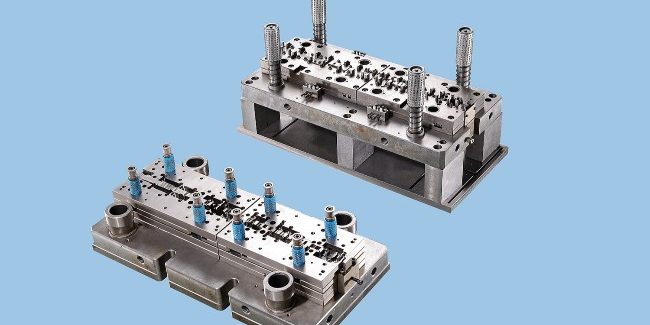In the progressive die, the shape of the punch is formed by punching the spare material around the punch. The influence of blanking force is the main reason of blanking and distortion. During blanking, because of the blanking gap, the data is stretched on one side of the die (the data is warped upward) and tightened on the punch side. When the discharge plate is used, the discharge plate is used to press the data to avoid the upward warping of the data on the die side. At this moment, the force of the data is changed accordingly. As the unloading plate increases its pressing force, the data on the punch side will be stretched (the tightening force tends to decrease), and the data on the concave die will be stretched (the tensile force tends to decrease). The overturning of stamping parts is caused by the tension of the data on the die surface. Therefore, when blanking, pressing and pressing the data is the key point to avoid the blanking and distortion.

The method of inhibiting stamping parts from turning over and distorting
- Reasonable mold planning. In progressive die, the organization of blanking order may affect the forming accuracy of stamping parts. For the blanking of small parts of stamping parts, generally a large area of blanking is organized first, and then a small area of blanking is organized to reduce the impact of blanking force on the forming of stamping parts.
- Press the data. Overcoming the traditional mold planning structure, the capacity gap is opened on the discharge plate (that is, when the mold is closed, the discharge plate and the concave die fit together, and the gap between the discharge plate and the concave die in the containing data section is t-0.03~0.05mm). In this way, the movement of the discharge plate in the stamping is stable, and the data can be pressed. The key forming part, the unloading plate must be made into an insert type structure, in order to facilitate the treatment of long-term stamping caused by the grinding (pressing) loss of the unloading plate pressing part, but can not press the data.
- Add pressure function. That is, the thickness of the pressing part of the unloading insert is increased (the normal thickness of the unloading insert is H+0.03mm) to add the pressure on the data of the die side, and then prevent the stamping parts from turning over and distorted deformation during punching.
- Trim the inclined plane or arc at the end of the punch cutting edge. This is an effective way to slow the blanking force. Slow down the blanking force, can reduce the tensile force on the die side data, and then to inhibit the stamping parts to turn over and distort the role.
- In daily mold production, attention should be paid to protecting the sharpness of punching convex and concave die cutting edge. When the punching edge is worn, the tensile stress of the data will increase, and then the stamping parts will increase the tendency of flipping and distortion.
- Unreasonable blanking gap or uneven gap is also the cause of stamping parts flipping and distortion, which should be overcome.
Handling common specific problems in production
In daily production, will encounter punching scale is larger or smaller (may exceed the requirements of the specifications) and the punch scale is larger than the scene, in addition to consider the forming convex, concave die planning scale, processing precision and blanking gap and other factors, should also be considered from the following aspects to deal with.
- When the punching edge is worn, the tensile stress of the data increases, and the stamping parts tend to turn over and distort. When turning material occurs, the punching scale will become smaller.
- Strong pressure on the data will cause plastic deformation of the data, which will lead to larger punching scale. When the pressure is reduced, the punching scale will be smaller.
- Shape of punch edge end. If the end is trimmed out of the inclined plane or arc, because the punching force is slowed down, the punching part is not easy to turn over and distort, so the punching scale will become larger. When the punch end is flat (without bevel or arc), the punching scale will be smaller.






